Three Decades of Memories -The History of the National Show Glass Commemoratives
Reprinted from "Crown Jewels of the Wire", May 1999, page 19
The Commemorative Originators, Frank and Margaret Miller
(Part II)
Production Colors
The production colors from 1977 through 1984, 1987, and 1989 through 1999
were all chosen from the tested production colors used by the Mosser Glass
Company. The colors used in 1985 (teal blue), 1986 (lime green with amber
swirls), and 1988 (dark cornflower blue), were specially ordered by the
McDougalds in conjunction with requests by the national show hosts. In each
case, a sample of a known glass product was submitted to Mosser and then sent on
to Coming Glass (New York) for analysis of its composition.
1980 Commemorative Embossing:
11TH NIA CONVENTION
HERKIMER, N.Y. JULY 11-13 1980
1981 Commemorative Embossing:
12TH NIA CONVENTION
SACRAMENTO, CALIF. JULY 10-12 1981
The cost of the 1981 commemorative was $10.00 each.
1982 Commemorative Embossing:
10TH NIA CONVENTION
DENVER, COLORADO JULY 20-22 1979
In 1982 the cost of the commemorative reached $12.00 each.
1983 Commemorative Embossing:
14TH NIA CONVENTION
ROCHESTER, N.Y. JULY 8-10, 1983
In 1984, the first commemorative in a slag glass was produced using a white
milkglass and a red transparent glass mixture. Mosser Glass Company produced 320
units. When advertised, the insulators sold out immediately, before all the
orders could be filled or insulators held back to take to the national show in
Tacoma. The McDougalds panicked and begged Mosser to run another 100 of the
commemoratives so the orders received could be filled. Unfortunately, Mosser was
unable to run another 100, for their tanks had been cleaned and they were into
productions of other colors. They suggested that Robert Wetzel of Zanesville,
Ohio, be contacted to provide the additions to the run. Wetzel, a mould-maker by
trade, also had small glass furnaces, a press and cooling lehr behind his home.
He examined the samples run by Mosser and determined that he could duplicate
exactly what Mosser had produced... a white milkglass with a red transparent
glass swirling. In order to prove he could press the commemoratives, the mould
was transferred from Mosser to Wetzel's home. Wetzel pressed out five samples of
the commemorative in the glass that he was working in at the time. He mailed the
samples to the McDougalds. "We expected to see the white and red
combination, but instead they were a cobalt blue with milky white swirls,
relayed McDougald. Wetzel did fill the second run order of 100, but the units
never achieved the quality of red-swirling color that Mosser had produced. The
red transparent glass broke down into blue and yellow hues and didn't match the
color of those run at Mosser.
The selling price per commemorative was $14.00 in 1984. Much of the increase
reflected the use of a slag glass, which required two tanks of glass--- white
milkglass and red transparent. To watch the production was very interesting. One
gatherer placed red glass into the mould followed by a second gatherer's rod of
white milkglass. The insulator was pressed, but no swirling occurred. Five more
insulators were pressed this way. Since that was not the desired effect, the
order in which the glass was placed in the mould was changed.
White milkglass was placed in the mould first, followed by the red
transparent glass. They tried nine more samples, but it was not swirling. In
order to get the slag to work properly in the mould, a flotation collar, much
like a doughnut, was placed into the tank on top of the surface of the molten
white milkg1ass. A gathering rod was used to pull out a small quantity of the
red transparent glass which was dropped into the collar. The two colors were
then swirled together within the collar as it floated on top of the white
milkglass and then dropped as a pre-swirled gob of molten glass into the mould
to be pressed. About four slag glass commemorative insulators could be pressed
before more red glass was needed. No two insulators are alike when a slag glass
is used. A slag glass was also used in 1990, 1991, and 1993.
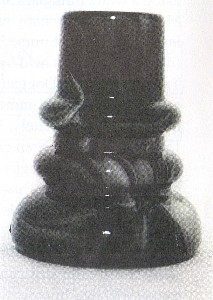
Cobalt with white milkglass swirls
sample sent by Wetzel Glass.
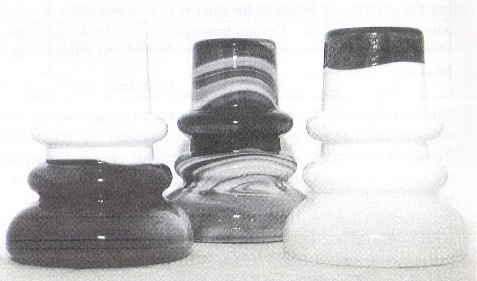
Two unsuccessful slag glass attempts flank the right combination.
1984 Commemorative Embossing:
15TH NIA CONVENTION
TACOMA, WASHINGTON JULY 20-22 1984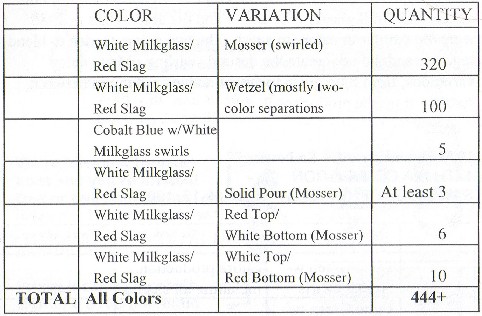
In 1985 a badly damaged CD 102 Diamond teal blue pony was matched for use in
the commemorative for the 16th national held in St. Charles, Illinois.
1985 Commemorative Embossing:
16TH NIA CONVENTION
ST. CHARLES, ILLINOIS JUNE 7-9 1985
A sample of a Saratoga soda bottle was submitted (but not crushed) to match a
"green glass with amber swirls" for the 1986 national in Saratoga
Springs, New York. This was the first time that Mosser had tried to mix two
transparent glass colors. That should have been a warning sign right then. Amber
glass was gathered from its tank and placed in a flotation collar on the surface
of the green glass. The two colors were swirled together and dropped into the
mould. (In 1984 when white milkglass and transparent red were used there was a
major difference in glass density between the two colors, so the red color
swirled effectively in the dense white milkglass.) The amber and the green glass
in 1986 were too similar in nature to swirl. The two colors tended to blend
together and did not create the desired swirling. Many color variations, from
lime green to amber and everything in between, resulted from the production.
1986 Commemorative Embossing:
17TH NIA CONVENTION
SARATOGA SPRINGS, NY JULY 11-13, 1986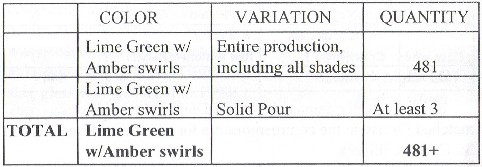
1987 Commemorative Embossing:
18TH NIA CONVENTION
FRESNO, CALIFORNIA JULY 24-26, 1987
A beautiful dark cornflower cordial glass was analyzed for the Houston
national in 1988 hoping that it would replicate the beautiful flower fields of
bluebonnets that are indigenous to that state.
1988 Commemorative Embossing:
19TH NIA CONVENTION
HOUSTON, TEXAS JULY 22-24, 1988
Dome Logo: Texas state outline and five point star for Houston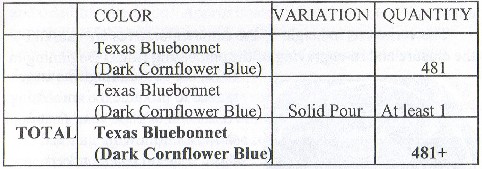
In all three cases of special-order colors, because of the greater thickness
of the glass in the commemorative and the instability of the glass mixtures, the
production color results were not what was anticipated by the show hosts or the
McDougalds. And, due to the fact that the colors were special order, absolutely
no guarantees are made by the glasshouse when new formulas and unproven recipes
are used. The commemoratives had to be taken "as produced." Finding a
new color each year continues to be a challenge, but past experiences dictate
that it is better to play it safe with the known than sorry with the unknown of
special requests for colors. In the last five years, there have been no
opportunities to select from previous colors manufactured. The colors used must
be on Mosser's production schedule.
Changes in the Mould
Since 1970, the national commemorative mould has undergone virtually no
changes except for the replacement of embossing rings. The plunger still
embosses an "FM" inside the top of the pinhole which honors Frank
Miller, its originator. With the number of new glass colors dwindling, an
attempt to bring some individuality to each year's run was begun in 1988. At
that time, a logo synonymous with the national show was embossed on the top of
the dome of each commemorative. You will remember that the top of the dome was
used for the location of the show embossings for the first two years in 1970 and
1971. When Frank Miller saw the 1988 commemorative with the outline of the state
of Texas and a "lone star" at the location of Houston, he said,
"Who was the genius that came up with finding a way to emboss the dome
again?!?" It seemed he had always liked the embossing on the top of the
insulator and was happy to see it was being used once again.
The variations in height of the commemoratives are caused by the erasure and
re-engraving of the embossing rings. Beginning in 1972, the bottom ring was
engraved to produce the embossing. At the end of each year's national show, the
following national show location is announced. As soon as the dates are
confirmed, the embossing ring is erased and re-engraved with the new show
information. This causes the depth of the glass at the bottom of the mold to
increase, making each insulator "grow in height" approximately .030
inches each year. This change in height is not discernible from year to year,
but readily noticed if comparing 1972 with 1984.
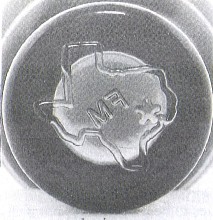
The first year dome embossing
was restored was in 1988.
The McDougalds received two base embossing rings from the Millers at the time
the mould transferred ownership. They were erased and re-engraved, alternating
the rings each year, until 1985. That year a new embossing ring had to be
ordered, and the overall height of the commemorative was reduced since the ring
was brand new. With both erasure and embossing occurring with the dome plate
necessary each year beginning in 1988, the growth in height continues on both
the dome and the base. Approximately four years of erasures/embossings are
gotten from the embossing plate and ring, so every fourth year the overall
height of the commemorative decreases. If you line up the complete set of
commemoratives, these changes are very apparent.
How Are The Commemoratives Made?
Production day at a glass plant is a fascinating process to watch. The day
before production, the cast iron mould is cleaned and oiled for operation.
Approximately ninety minutes prior to the beginning of the run, the mould and
plunger are placed into the lehr and slowly heated to a temperature of
approximately 1000 degrees Fahrenheit.
Also mixed the day before the run are 2000 pounds of sand, soda ash, potash,
lime, hydrated aluminum and other ingredients and coloring agents specific to
the recipe called for to produce a given color product. Some batches also
include crushed cullet (glass of the same color from poorly molded pieces broken
and saved from a earlier run).
The BATCH is placed into the DAY TANK and melted for use in the production
run the next day. Its temperature needs to reach 2600 degrees Fahrenheit by the
time production begins. Once the heated mould is positioned on the press,
production is ready to begin.
The GATHERER uses a long rod, called a punty hook, to remove molten glass
from the day tank. A slow twirling motion of the punty hook gathers the right
amount of molten glass on the end of the rod. The gatherer then moves the punty
hook loaded with molten glass towards the waiting, heated mould. The molten
glass drops to a temperature of 1950 degrees Fahrenheit by the time it reaches
the mould.
The gatherer holds the molten glass over the mould. Gravity takes over, and
the molten glass begins to drop towards the waiting mould. The PRESSER takes
shears in his right hand and cuts off the correct amount of molten glass from
the punty hook and lets it drop into the closed mould.
With his left hand, the presser takes the embossing ring from a hot plate and
places it upside-down on top of the closed mould, so the embossing is facing the
molten glass inside the mould. With the mould secured and the embossing ring in
place, the presser pulls on the lever with both hands to lower the plunger into
the mould. The plunger displaces the molten glass inside the mould and pushes it
upwards against the embossing ring. The plunger, which contains the engraved
initials "FM" (for "Frank Miller"), embosses the top inside
of the commemorative's pinhole.
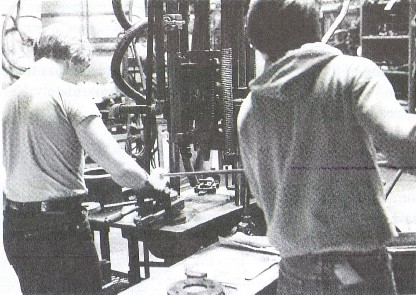
The gatherer brings molten glass to the mould where
the presser shears off the correct amount to press.
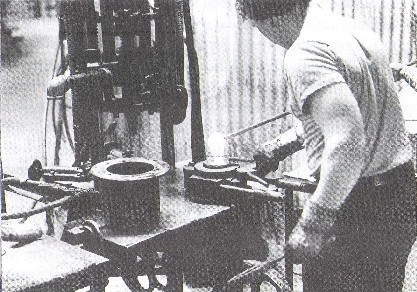
The plunger is then raised, the embossing ring removed and the mould
reopened. The TURNING-OUT BOY uses tongs to remove the red hot commemorative
from the mould. It is also his job to examine the insulator for readily
discernible flaws--poor embossing, stones, cracks, and other imperfections.
Defective pieces are immediately placed in a large cart filled with water. As
imperfect units hit the water, they immediately shatter internally, making them
easily readied to become cullet for another run of the same color.
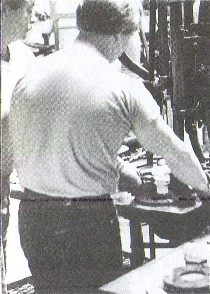
Preparing to remove the pressed
insulator from the mould.
Perfect units rest momentarily on an asbestos screening. Two hot AIR JETS
begin cooling the insulator. The turning-out boy then places the good
commemoratives onto a GLAZING WHEEL. The wheel is similar to a carousel which
has 16 rotating pallets that continuously turn each insulator, exposing its
surfaces to flame jets which polish the glass and remove any imperfections such
as excess glass that might have oozed through seams between the mould and
embossing ring.
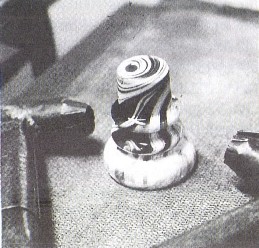
Air jets begin cooling process.
Should a carnivalization or similar surface coloring treatment
be desired, it would be applied directly to the insulator prior to it being
fired on the glazing wheel. The "carousel ride" for each insulator
takes about one minute.
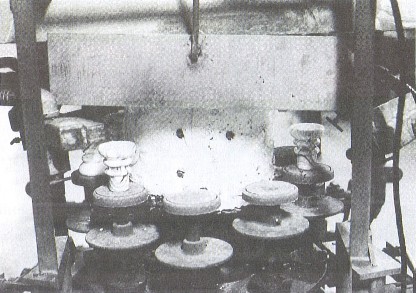
The GLAZER MAN removes the insulators from the glazing wheel and
places them on a long-handled metal spatula -- just big enough to carry two
insulators. The temperature of the glass is now approximately 1000 degrees
Fahrenheit.
Two by two, the commemoratives are carried by the glazer man to
the LEHR. This is a 75 to 100 foot long heavy wire mesh belt which
"rides" through a cool-down oven. The temperature at the press room
end is 1000 degrees Fahrenheit. The other end of the lehr delivers a cooled
insulator to the final INSULATOR GLASS PACKER. The glass is cooled to 100
degrees Fahrenheit by the time it reaches the packing room. Glass factories can
regulate the speed of the belts running through the lehrs. It is very possible
that another product can be cooling on a second track which may require a longer
or shorter ride in order to anneal the glass properly.
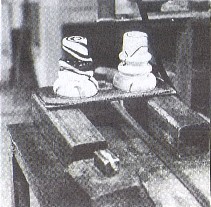
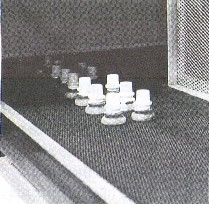
The annealed commemoratives
approach the end of the cooling lehr
and emerge into the room for packing.
| 